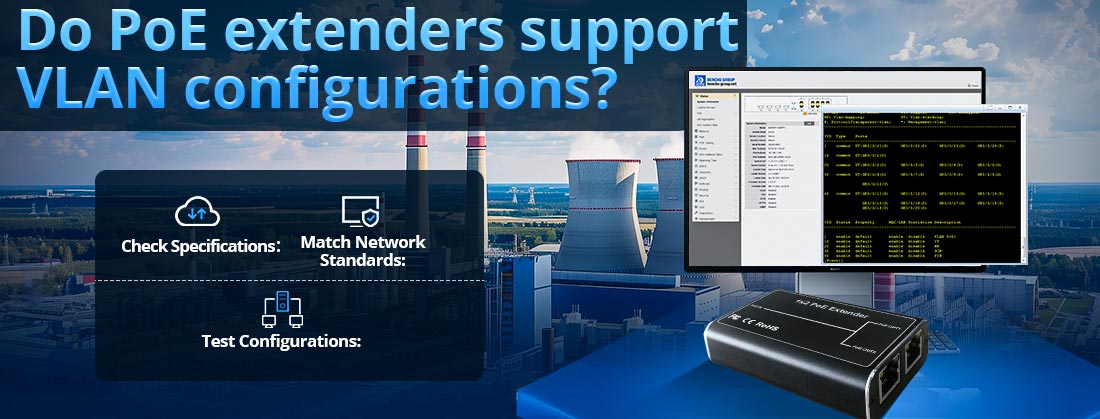
Os extensores PoE suportam configurações de VLAN?
Os extensores Power over Ethernet (PoE) são projetados principalmente para estender o alcance de dispositivos habilitados para PoE, amplificando sinais de energia e de dados. Embora sua funcionalidade principal normalmente não inclua recursos de rede avançados, como configuração de VLAN (Virtual Local Area Network), alguns extensores PoE avançados e dispositivos de rede com recursos PoE podem oferecer suporte para passagem de VLAN ou até mesmo marcação de VLAN.
Aqui está uma explicação detalhada de como os extensores PoE interagem com as configurações de VLAN:
1. Noções básicas de VLAN
Uma VLAN é uma tecnologia de segmentação de rede que permite que dispositivos em uma rede física compartilhada se comuniquem como se estivessem em redes separadas. As VLANs melhoram o desempenho da rede, aumentam a segurança e simplificam o gerenciamento da rede.
As VLANs são configuradas em switches e roteadores de rede, com recursos importantes como:
--- Marcação de VLAN: Atribuição de um ID de VLAN (definido no padrão IEEE 802.1Q) a pacotes de dados.
--- Passagem de VLAN: Permitir que o tráfego de VLAN marcado passe de forma transparente através de dispositivos que não processam IDs de VLAN.
2. Extensor PoE e passagem VLAN
Maioria Extensores PoE operam como dispositivos de Camada 1 ou Camada 2 no modelo OSI, o que significa que normalmente não modificam ou processam pacotes de rede. Como tal, eles podem suportar tráfego VLAN das seguintes maneiras:
um. Suporte VLAN Transparente
--- Os extensores PoE geralmente suportam passagem de VLAN, permitindo que pacotes VLAN marcados viajem ininterruptamente através do extensor.
--- Isso é particularmente útil em cenários onde as VLANs são configuradas em switches ou roteadores de rede upstream para segregar o tráfego para dispositivos como câmeras IP ou pontos de acesso sem fio.
b. Compatibilidade
--- Para garantir que o tráfego VLAN seja transmitido sem problemas, o extensor PoE deve suportar as mesmas velocidades de dados (por exemplo, Gigabit Ethernet) e padrões (por exemplo, IEEE 802.3af/at/bt) que os dispositivos habilitados para VLAN.
3. Extensores PoE avançados com recursos VLAN
Embora os extensores PoE básicos não ofereçam configurações específicas de VLAN, alguns modelos avançados – geralmente chamados de extensores PoE gerenciados – podem incluir recursos relacionados à VLAN:
um. Marcação de VLAN
--- Extensores PoE gerenciados com funcionalidade de Camada 2 podem permitir que os administradores configurem a marcação de VLAN diretamente no extensor. Isto é útil em configurações de rede complexas onde é necessária segmentação adicional.
b. Isolamento de VLAN
--- Alguns extensores oferecem isolamento de VLAN, que pode ser configurado para evitar comunicação cruzada entre dispositivos conectados. Esse recurso aumenta a segurança, especialmente em cenários como redes Wi-Fi públicas.
c. Gerenciamento de VLAN
--- Os extensores PoE gerenciados podem incluir uma interface para configuração e monitoramento de VLAN, tornando-os mais versáteis em ambientes corporativos.
4. Casos de uso para extensores PoE e VLANs
Os extensores PoE que suportam passagem de VLAN ou recursos de VLAN são valiosos em vários cenários:
--- Redes de câmeras IP: VLANs são usadas para segregar o tráfego de vigilância da rede principal para segurança e desempenho. Os extensores PoE permitem que câmeras sejam instaladas em longas distâncias sem interromper as configurações de VLAN.
--- Pontos de acesso sem fio: VLANs são frequentemente usadas para separar o tráfego Wi-Fi de convidados das redes internas. Os extensores PoE garantem que os pontos de acesso possam ser implantados longe dos switches de rede, mantendo a integridade da VLAN.
--- Redes Industriais: Na automação industrial, VLANs são usadas para isolar dados críticos da máquina. Os extensores PoE permitem que sensores e dispositivos permaneçam conectados por longas distâncias, preservando as configurações de VLAN.
5. Garantindo a compatibilidade de VLAN
Para garantir que um extensor PoE suporte tráfego VLAN:
--- Verifique as especificações: verifique se o extensor suporta passagem de VLAN ou recursos avançados de VLAN.
--- Combine os padrões de rede: certifique-se de que o extensor seja compatível com as velocidades e padrões de dados (por exemplo, Gigabit Ethernet, IEEE 802.1Q) dos dispositivos conectados.
--- Configurações de teste: teste a configuração para confirmar se os pacotes marcados com VLAN são transmitidos corretamente através do extensor.
Conclusão
Embora os extensores PoE padrão não suportem inerentemente a configuração de VLAN, eles geralmente são compatíveis com passagem de VLAN, garantindo que o tráfego marcado com VLAN seja transmitido de forma transparente. Para funcionalidades avançadas de VLAN, como marcação ou isolamento, podem ser necessários extensores PoE gerenciados. Esses recursos são particularmente benéficos em ambientes de redes empresariais, industriais ou de vigilância, onde as VLANs são amplamente utilizadas para segmentação e segurança.